Ashnola Watershed Wildfire Reforestation
Projects Sponsor
In August 2023 a devastating wildfire scorched 44,000 hectares of the Ashnola Watershed, severely impacting the land and its ecosystems. In response the Lower Similkameen Indian Band joined forces with Tree Canada and Cariboo Carbon Solutions to launch a culturally grounded reforestation initiative. Guided by sməlqmix cultural values and ecological stewardship the team began riparian planting within just two months of the fire. Today, aspen stands waist-high signalling early success. By July 2025 more than 436,000 seedlings had been planted with an additional 380,000 slated for 2026. This project aims to restore biodiversity, provide vital shade to cool the watershed’s rivers, and protect food and water sovereignty.
The Ashnola River winds through the territory of the sməlqmix people. Its waters—full of life—flow into the Similkameen River, whose health has long been compromised by the legacy of mining. For generations, the Ashnola has sustained the Lower Similkameen Indian Band (LSIB), feeding families and anchoring a culture inseparable from the land.
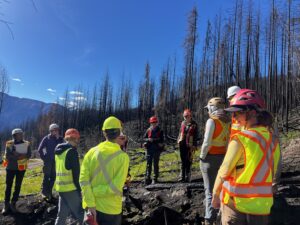 But in recent years this delicate system has begun to show signs of strain. Rising water temperatures signalled the approach of a tipping point—and the looming threat of ecological collapse. The sməlqmix people have witnessed the rhythms of the Ashnola River for thousands of years. This long memory forms the benchmark—an understanding of how the river should flow, feel and nourish. When water quality testing revealed serious contamination in the Similkameen River downstream the Lower Similkameen Indian Band took urgent steps to ensure the upstream Ashnola would remain clean and protected.
But in recent years this delicate system has begun to show signs of strain. Rising water temperatures signalled the approach of a tipping point—and the looming threat of ecological collapse. The sməlqmix people have witnessed the rhythms of the Ashnola River for thousands of years. This long memory forms the benchmark—an understanding of how the river should flow, feel and nourish. When water quality testing revealed serious contamination in the Similkameen River downstream the Lower Similkameen Indian Band took urgent steps to ensure the upstream Ashnola would remain clean and protected.
In July 2023, just two months before disaster struck, the Band hired a biologist and began developing a water-cooling plan to protect the Ashnola’s lifeblood. Then came the fire, stripping hillsides and riparian corridors bare.
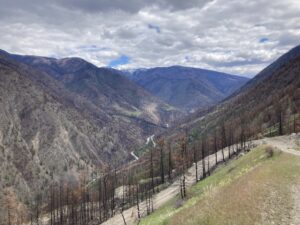 What had started as a thoughtful preventative initiative became a race against time. The objective now was clear: to re-establish native vegetation—especially in riparian zones—to create shade, slow erosion, restore forest cover and safeguard this sacred river for generations yet to come.
What had started as a thoughtful preventative initiative became a race against time. The objective now was clear: to re-establish native vegetation—especially in riparian zones—to create shade, slow erosion, restore forest cover and safeguard this sacred river for generations yet to come.
It was while the fire was ablaze that a serendipitous meeting helped bring the project to life. Julie Budgen, a professional biologist with Covidae Environmental Consulting and the lead on LSIB’s water-cooling plan had just met MacKendrick Hallworth, a forester-in-training (at the time) with Cariboo Carbon Solutions (CCS) seeking a meaningful reforestation project. Julie introduced him to LSIB and from that point momentum built quickly.
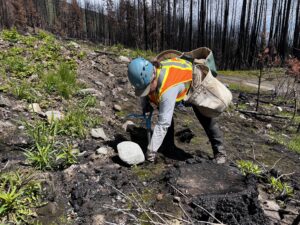 At its core the Ashnola Reforestation Project is about watershed protection, food sovereignty and ecological restoration. The goals: protect water quality, encourage the return of huckleberries to support traditional foods, create habitat for grizzly bears and reintroduce endangered whitebark pine.
At its core the Ashnola Reforestation Project is about watershed protection, food sovereignty and ecological restoration. The goals: protect water quality, encourage the return of huckleberries to support traditional foods, create habitat for grizzly bears and reintroduce endangered whitebark pine.
Together LSIB and CCS identified a near-term opportunity to plant 15000 aspen across key creek draws and secured an additional 1250 whitebark pine and 100 huckleberry plants to begin restoring food and habitat systems. A successful funding proposal was submitted to Tree Canada and a permit application was promptly approved by the Ministry of Forests. The planting prescription written by RPF Mike Madill guided the implementation.
Elders blessed the work and planting began almost immediately after the fire’s final plumes of smoke had cleared. In tandem over 300 hectares were surveyed to lay the groundwork for future phases and valuable lessons were learned.
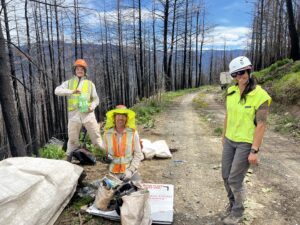 Because the project developed so quickly—moving from concept to implementation and then sowing for future years within a matter of weeks—some areas had not been fully ground-truthed until shortly before planting began. In a steep and mountainous landscape like the Ashnola this created real logistical challenges particularly in coordinating crews and ensuring trees could be delivered and planted on schedule.
Because the project developed so quickly—moving from concept to implementation and then sowing for future years within a matter of weeks—some areas had not been fully ground-truthed until shortly before planting began. In a steep and mountainous landscape like the Ashnola this created real logistical challenges particularly in coordinating crews and ensuring trees could be delivered and planted on schedule.
Fortunately, pre-prepared contingency plans and highly adaptable, hard-working planting crews who were able to pivot quickly saved the day. These teams showed remarkable resilience and flexibility in the field allowing the project to stay on track despite difficult terrain and evolving access constraints. Going forward, expanded ground reconnaissance and earlier access verification will be incorporated into the planning process for all future phases of reforestation in the watershed.
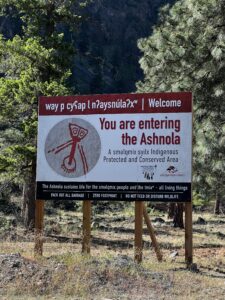 By spring 2024 an additional 46,000 aspen were planted. In 2025 420,000 additional seedlings sown two years prior were successfully planted under a multi-year Tree Canada contract supported by follow-up permits from the Ministry of Forests.
By spring 2024 an additional 46,000 aspen were planted. In 2025 420,000 additional seedlings sown two years prior were successfully planted under a multi-year Tree Canada contract supported by follow-up permits from the Ministry of Forests.
Much of the project’s success lies in the fact that it is grounded in sməlqmix Law and Leadership. The project is not just about planting trees—it reflects sməlqmix responsibilities to water land and all living relatives. It is guided by LSIB’s water strategy Natural Law and deep place-based knowledge that has been carried through generations. Every step is shaped by the understanding that water is life and land must be cared for in relationship—not controlled.
Born out of urgency the project a landscape-level response to crisis moved from concept to implementation in weeks. It now spans hundreds of hectares and multiple years, integrating reforestation and habitat recovery and addresses climate impacts, wildfire recovery and species protection all at once, with partnerships spanning disciplines and organizations.
The project demonstrates that when Indigenous Nations lead and when partnerships respect their stewardship goals, rapid effective and meaningful action is possible. Beyond trees, what’s been planted is a practical model: a stellar example of culturally driven, ecologically sound, and logistically adaptable action. Others facing similar crises can draw from this approach to build their own place-based solutions.













